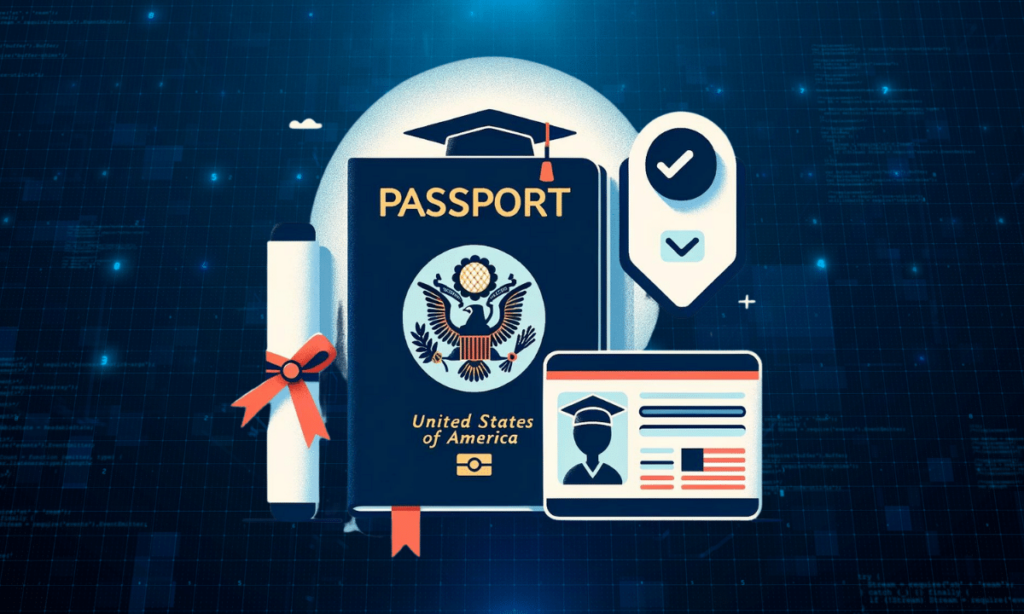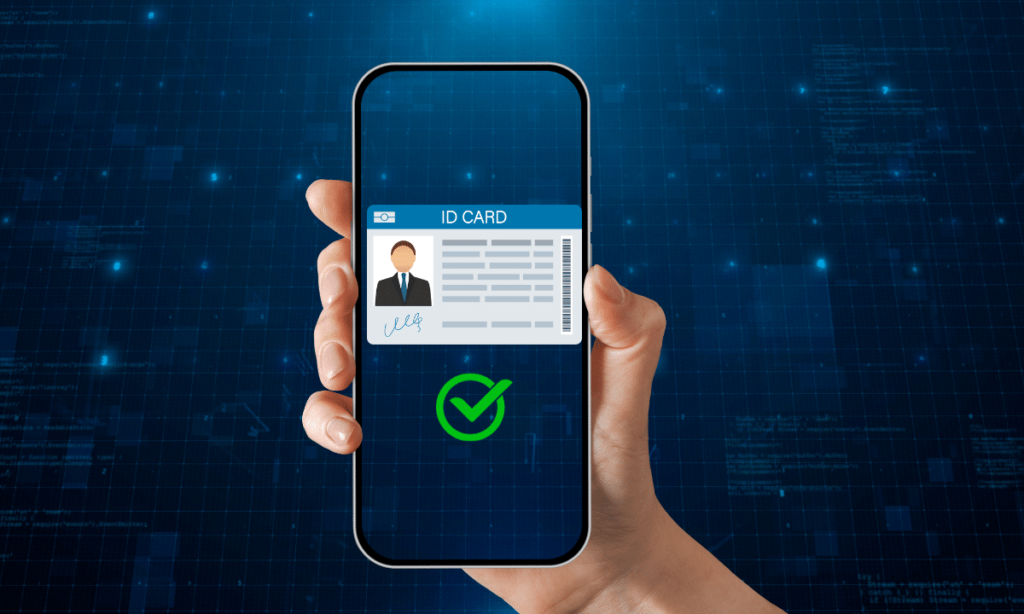Table of Contents
- 1 Key Takeaways:
- 2 What Are Credentials?
- 3 The Need for Reliable Digital Credential Verification
- 4 What Are Verifiable Credentials?
- 5 The Role of the World Wide Web Consortium (W3C) in Developing Verifiable Credentials
- 6 What Does the Verifiable Credentials Ecosystem Consist of?
- 7 How Verifiable Presentations Enable Selective Data Sharing
- 8 Role of Digital Signatures in Verifying Credentials
- 9 How Digital ID Wallets Manage Verifiable Credentials
- 10 The Verifiable Credentials Trust Model: A Trustless System
- 11 What Are the Key Components of Verifiable Credentials?
- 12 The Benefits of Verifiable Credentials
- 13 The Role of Decentralized Identifiers (DIDs) in Verifiable Credentials
- 14 Conclusion
- 15 Identity.com
Key Takeaways:
- Verifiable Credentials (VCs) are digital credentials that are cryptographically verified, enabling instant and secure identity verification. These credentials are issued by trusted authorities and are designed to verify specific information about an individual or entity.
- Verifiable credentials allow individuals to share only the necessary information, protecting privacy by limiting the exposure of personal data.
- Designed for interoperability, verifiable credentials enable seamless verification across multiple platforms and services, enhancing flexibility and user experience.
In the Web 2.0 era, most internet users establish unique connections with various online services, such as Amazon, Netflix, Facebook, Upwork, and Airbnb, through individual registrations. These connections are typically secured using email addresses and passwords, allowing users to present different identities and credentials as needed.
Service providers, especially in sectors requiring Know Your Customer (KYC) compliance, have embraced digital transformations like e-KYC to streamline processes. This shift requires users to submit digital copies of personal documents, including social security cards, driver’s licenses, and passports.
As the digital landscape evolves, verifiable credentials offer a promising solution for enhancing trust and security in digital identity management. This guide will dive into the concept of verifiable credentials, exploring how they function and the benefits they offer.
What Are Credentials?
Credentials serve as evidence of an individual’s accomplishments, qualifications, experiences, or other significant aspects of their identity. Common elements found in credentials include:
- Personal Identification: Typically Includes the owner’s name, photo, and ID number.
- Issuing Authority’s Details: Features symbols or logos of the issuing body (e.g., state government symbols).
- Specific Information: Contains details like health insurance information, passport data, driver’s license specifics, etc.
- Method of Acquisition: Indicates how the credential was earned.
- Grades or Ratings: May include academic classifications (e.g., first class honors) or professional awards (e.g., “Top Performer” in a field).
- Constraints or Limitations: Often have validity periods or specific usage terms.
The Need for Reliable Digital Credential Verification
Verifying the authenticity of credentials has become a critical challenge across various sectors, including healthcare, social media, and employment platforms. The widespread presence of fake credentials poses significant security risks and enables fraudulent activities. For instance, identity theft and related fraud have surged, with the U.S. Federal Trade Commission reporting over 2.6 million cases in 2023, leading to more than $10 billion in losses.
While digitizing credentials has streamlined many organizational processes and reduced the need for manual verification, it has also introduced new challenges, notably the rise of counterfeit digital identities. This shift has raised important questions about the verification process: How can organizations confidently and accurately verify a user’s credentials? Is there a way to authenticate credentials quickly and directly from the issuer, bypassing slower, traditional methods?
Consider scenarios where verifying a person’s educational background, such as a Harvard Business School degree, or health status, such as COVID-19 vaccination, is essential. Traditionally, these verifications involved lengthy, inefficient processes, including phone or email communications with issuing institutions. This is where the concept of verifiable credentials offers a solution. But the question remains: Can verifiable credentials provide a faster, more reliable means of verifying information directly from the source?
What Are Verifiable Credentials?
Verifiable Credentials (VCs) are tamper-evident, cryptographically secure digital credentials used to verify specific claims about an individual or entity. Issued by trusted authorities, VCs enable the holder to selectively disclose only the necessary information, ensuring privacy and control over personal data. Unlike traditional credentials, VCs can be instantly and independently verified through cryptographic methods, enhancing trust and security in digital interactions.
For example, a verifiable credential could represent a digital driver’s license, a university diploma, or proof of employment. VCs stand out because they allow third-party verifiers to validate them without requiring access to unrelated personal information. This feature makes VCs especially valuable in digital identity systems, where security, privacy, and trust are essential.
The Role of the World Wide Web Consortium (W3C) in Developing Verifiable Credentials
The World Wide Web Consortium (W3C), an international organization that sets standards for the web, has played a pivotal role in the development of Verifiable Credentials (VCs). By establishing open standards, W3C ensures that verifiable credentials are interoperable, secure, and privacy-centric across various platforms and services.
The W3C’s Verifiable Credentials Data Model provides the foundational framework for issuing, holding, and verifying digital credentials. By leveraging decentralized technologies such as blockchain and Decentralized Identifiers (DIDs), this model enables VCs to be trusted without relying on centralized authorities. This structure ensures that individuals maintain control over their personal data while proving their identity or credentials, enhancing both privacy and security.
W3C’s efforts have made verifiable credentials adaptable across multiple industries, including education, finance, healthcare, and government services. These open standards allow organizations to securely integrate VCs into their processes, enabling real-time credential verification with minimal risk of fraud.
What Does the Verifiable Credentials Ecosystem Consist of?
The three key roles in the Verifiable Credentials ecosystem consist of the issuer, holder, and verifier.
1. Issuer
The issuer is the entity responsible for creating and issuing verifiable credentials. This could be an institution such as a university, government agency, or professional organization. For instance, a university like Harvard may issue a digital diploma to its graduates, certifying their academic achievements. The issuer digitally signs the credential, ensuring its authenticity and integrity.
2. Holder
The holder is the individual or organization that possesses and manages the credential. Typically, the holder stores their credentials in a secure digital wallet and has control over who can access and verify the credential. For example, a Harvard graduate could store their diploma digitally and share it for verification when needed, such as during a job application process.
3. Verifier
The verifier is the party that requests and checks the authenticity of the credential. By inspecting the digital signature, the verifier ensures that the credential is valid and hasn’t been tampered with. In use cases like job applications, an employer may act as the verifier to confirm the educational background of a candidate by checking their digital diploma.
How Verifiable Presentations Enable Selective Data Sharing
Verifiable Presentations are a key component of verifiable credentials, enabling users to interact securely with various entities or organizations. They allow individuals to consolidate data from multiple credentials into a single, secure format, ensuring that the source of these credentials is verifiable. This feature proves especially useful when users need to meet specific information requests from organizations.
The most significant advantage of Verifiable Presentations is their ability to enable selective information sharing. For instance, if an organization requests personal details such as name, nationality, education, employment history, and insurance information, you would traditionally need to provide multiple documents, often revealing more information than necessary. Verifiable Presentations solve this issue by allowing individuals to share only the relevant information from their various credentials. These selected data points are then compiled into a single, structured presentation, which is digitally signed to ensure both authenticity and user privacy.
Role of Digital Signatures in Verifying Credentials
Digital signatures play a critical role in verifying credentials by ensuring the authenticity, integrity, and security of verifiable credentials (VCs). Acting as the electronic equivalent of handwritten signatures or seals, digital signatures enhance trust in the credential verification process. They confirm to the verifier that the credential or verifiable presentation truly originates from the claimed issuer and has not been tampered with.
When a user compiles data from their credentials into a verifiable presentation and submits it to an organization (such as an employer), digital signatures are applied to protect and verify the information. The process involves two cryptographic keys: the private key and the public key. The issuer uses their private key to digitally sign the credential, encrypting it in a way that only the verifier can decrypt using the public key. This ensures that the credential remains unaltered and verifies the source, providing confidence that the credential is legitimate and issued by a trusted entity.
In summary, digital signatures are essential for verifying credentials by ensuring data authenticity, preventing tampering, and building trust between the credential holder, the issuer, and the verifier.
How Digital ID Wallets Manage Verifiable Credentials
Digital ID wallets are secure apps on your smartphone or device that store and manage your digital identification credentials, such as digital versions of driver’s licenses, educational certificates, and professional achievements. These wallets use advanced security features like encryption and biometrics to ensure your personal information remains safe.
When it comes to managing these credentials, digital ID wallets play a crucial role. They not only store your verifiable credentials securely but also manage how they are shared and verified.
The wallets leverage cryptographic techniques to keep verifiable credentials tamper-proof and ensure that only you control who can access them. When you choose to share a verifiable credential, the digital ID wallet allows the recipient to instantly verify its authenticity without exposing any unnecessary personal information. This process empowers you with greater control over your digital identity, making it easier and safer to manage and share your credentials in a secure and privacy-preserving way.
The Verifiable Credentials Trust Model: A Trustless System
The trust model for verifiable credentials operates on a principle that simplifies and streamlines the establishment of trust by eliminating the need for extensive communication or permissions. In this model, the issuer trusts the holder as a credible recipient of the credential, and the verifier trusts the issuer as a competent authority. This creates a “trustless” environment, where all parties can confidently verify the validity of credentials without requiring detailed validation at each step.
One of the key strengths of this model is its flexibility. Any entity—whether a person, organization, or even an Internet of Things (IoT) device—can act as an issuer, holder, or verifier within the ecosystem. The growing integration of IoT devices into Web 3.0 further enhances the adaptability of verifiable credentials, expanding their potential uses and making them more accessible across different sectors.
Verifiers also have the freedom to set their own criteria for validating credentials, tailoring them to meet their specific needs. For example, a law firm hiring only Harvard Law School graduates can configure its system to accept credentials exclusively from Harvard, automatically filtering out other institutions without needing to manually verify every applicant. This makes the process more efficient and secure.
Key Criteria for Verifiers
Verifiers can specify additional criteria to assess the issuer’s competence and authority or to define the required dataset from the holder. These criteria may include:
- The type of credential
- The format type of the credential
- The use of specific cryptography
- The holder’s name (excluding sensitive information like date of birth or address)
- The holder’s proof of education (excluding specific grades)
- The holder’s age without additional personal details
- Credentials issued by a specific U.S. state
- Credentials issued by a specific country, etc.
What Are the Key Components of Verifiable Credentials?
Verifiable credentials have three key components:
1. Credential Metadata
This includes the credential identifier and any conditional information like terms of use and expiration dates. The issuer cryptographically signs this metadata.
2. Claim(s)
This tamper-proof component contains details about the individual who received the credential, such as claims, awards, achievements, job titles, employee numbers, courses of study, graduation grades, date of birth, nationality, and other relevant information related to the purpose of the credential.
3. Proof(s)
This section encodes information about the issuer of the VC, including proof of authenticity and whether the conveyed claims have been tampered with.
The Benefits of Verifiable Credentials
Traditional credential systems often face challenges like the proliferation of fake credentials. Verifiable credentials solve these issues by offering several benefits that enhance the efficiency, security, and privacy of credential management.
Here are the key advantages of verifiable credentials:
1. Instant Verification
Verifiable credentials enable fast and seamless verification, often within seconds, compared to traditional processes that can be time-consuming. Digital signature protocols using public key cryptography ensure the swift and secure authentication of credentials.
2. Secure and Tamper-Proof
Verifiable credentials leverage digital signatures and cryptographic techniques to protect data integrity. Public key cryptography ensures that credentials are tamper-evident, preventing unauthorized modifications and guaranteeing the authenticity of the credentials presented.
3. Limited Access and Privacy Protection
Verifiable credentials empower individuals to control their personal information by selectively sharing only the necessary details. This enhances privacy by allowing users to decide what information to disclose, protecting their data while fulfilling verification requirements.
4. Full Ownership and Control
Users have complete ownership and control over their verifiable credentials, which are securely stored in digital ID wallets. They can decide when and with whom to share their credentials and can revoke access at any time, maintaining full control over their personal data.
5. Ease of Use
Built on open standards, verifiable credentials are easy for developers to implement and intuitive for end users. Their standardized format facilitates integration into various systems, allowing users to combine data from multiple credentials to meet specific verification needs.
6. Interoperability and Compatibility
The interoperable design of verifiable credentials allows them to be used seamlessly across different platforms and services. For example, a verifiable credential can provide proof of age, while combining data from other credentials to verify nationality or employment status. This flexibility ensures that users share only the necessary data with authorized parties. Verifiable credentials are being adopted in various sectors, including healthcare, education, finance, and government, enhancing trust and security across these industries.
The Role of Decentralized Identifiers (DIDs) in Verifiable Credentials
Decentralized Identifiers (DIDs) are essential components in the ecosystem of verifiable credentials, enabling a decentralized and secure way to identify and verify users or entities. Unlike traditional centralized identifiers, DIDs are unique global identifiers. They operate on decentralized blockchain technology, providing a more robust and tamper-resistant method for managing digital identities.
DIDs are instrumental in establishing and proving the identity of entities involved in verifiable credentials. Entities use private keys to cryptographically link their identity to each credential they issue or hold, ensuring the authenticity and integrity of the credentials. This cryptographic binding allows for the secure verification of identity claims, whether from the issuer, holder, or verifier. During the verification process, the verifier uses the public key associated with the DID to confirm the validity of the verifiable credentials, ensuring that they are genuine and have not been tampered with.
To learn more about the significance of DIDs within the World Wide Web Consortium (W3C), click here.
Conclusion
Verifiable credentials are revolutionizing digital identity management by enhancing security, privacy, and efficiency. Utilizing advanced cryptographic techniques, they provide a more robust alternative to traditional methods, giving individuals more control over their personal information. Simultaneously, organizations benefit from streamlined verification processes. The global market for digital identity solutions, including verifiable credentials, is projected to grow from $13.7 billion in 2020 to $30.5 billion by 2025, with a Compound Annual Growth Rate (CAGR) of 17.3%. This growth underscores their potential to become a foundational element of the future digital landscape, transforming how identities are managed and verified across various sectors.
Identity.com
In the 21st century, verifying a user’s identity and the authenticity of their credentials has become increasingly urgent and crucial. Building on the decentralized ecosystem framework, VCs and DIDs are revolutionizing existing structures and offering new solutions. It’s exciting to see Identity.com playing a role in shaping this desired future as a member of the World Wide Web Consortium (W3C), the standards body for the World Wide Web.
The work of Identity.com as a future-oriented company is helping many businesses by giving their customers a hassle-free identity verification process. Identity.com is an open-source ecosystem providing access to on-chain and secure identity verification. Our solutions improve the user experience and reduce onboarding friction through reusable and interoperable Gateway Passes. Please refer to our FAQs page for more info about Identity.com and how we can help you with identity verification and general KYC processes.









